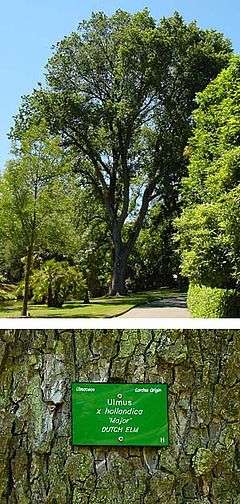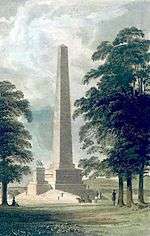''Ulmus'' × ''hollandica'' 'Major'
| Ulmus × hollandica cultivar | |
|---|---|
|
Ulmus × hollandica 'Major', Brighton, UK. | |
| Hybrid parentage | U. glabra × U. minor |
| Cultivar | 'Major' |
| Origin | northern France and Low Countries; (as cultivar) England |
Ulmus × hollandica 'Major' is a distinctive cultivar that in England came to be known specifically as the Dutch Elm, although all naturally occurring Field Elm Ulmus minor × Wych Elm U. glabra hybrids are loosely termed 'Dutch elm' (U. × hollandica). It is also known by the cultivar name 'Hollandica'. Helen Bancroft considered 'Major' either an F2 hybrid or a backcrossing with one of its parents.[1]
According to Richens the tree was a native of Picardy and northern France, where it was known from the fifteenth to nineteenth centuries as ypereau or ypreau.[2] 'Major' was said to have been introduced to England from the Netherlands in the late seventeenth century as a fashion-elm associated with William & Mary,[3] the name 'Dutch Elm' having been coined by Queen Mary's resident botanist Dr Leonard Plukenet.[4]
The epithet 'Major' was first adopted by Smith in Sowerby's English Botany 36: t. 2542, published in 1814, identifying the tree as Ulmus major. Krüssmann formally recognized the tree as the cultivar U. × hollandica 'Major' in 1962.[5]
Richens (1983) states that Elwes and Henry in their account of Dutch Elm (1913) "confused Dutch Elm with English".[6] He gives no evidence but can only have been referring to Henry's statement that "in many districts ['Major'] is the commonest tree in hedgerows".[7] Richens was writing seventy years after Henry, after a Dutch elm disease epidemic, two world wars, and decades of urbanisation and road-widening. Henry's statement was not necessarily a case of misidentification – or an exaggeration. Elwes and Henry's account of Dutch Elm remains a pioneering one.[8]
Description
In areas unaffected by Dutch elm disease, 'Major' often attains a height of > 30 m, with a short bole and irregular, wide-spreading branches. In open-grown specimens, the canopy is less dense than that of the English elm or Wych elm. The bark of the trunk is dark and deeply fissured and, like English elm, forms irregular 'plates' in mature specimens, serving to distinguish it from the Huntingdon Elm (latticed bark), the other commonly planted U. × hollandica in the UK.[9]
The leaves are oval, < 12 cm long by 7 cm wide, the top surface dark green and glossy, with a long serrated point at the apex.[10] The red apetalous, perfect, wind-pollinated flowers are produced in spring in large clusters of up to 50. The obovate samarae are up to 25 mm long by 18 mm broad. The cultivar may be distinguished from other elms by the corky ridges which on mature trees occur only on the epicormic branches of the trunk. On immature trees and suckers, the corky bark is more pronounced.
Elwes and Henry state that the seed is rarely viable, Bancroft that it is always sterile.[11] The tree suckers profusely from roots.[2][12][7] In the south of Britain, 'Major' is commonly found as a sucker, sometimes in mixed hedgerows with English Elm. Large Dutch Elm sucker-populations have been found in south west Wales, Cornwall and along the south coast of England. The suckers of Dutch Elm are sometimes confused with those of English Elm, which may explain the widespread and random occurrence of the former in hedgerows in southern Britain. 'Major' comes into leaf some three weeks later than English elm, and loses its leaves some three weeks earlier, and when young, its branching is straighter, stouter and more open. It is usually more vigorous than English elm.[7] The larger, tapering leaves, predominantly corky bark, and bold herringbone outline of Dutch Elm suckers also help to distinguish them from those of English elm.
.jpg) Typical open branching of unpollarded 'Major', Fettes Row, Edinburgh
Typical open branching of unpollarded 'Major', Fettes Row, Edinburgh- Corky wings on epicormic branchlets
- 'Major' leaves showing tapering apices
 Pressed 'Major' leaves, August
Pressed 'Major' leaves, August 'Major' forming hedgerows, Isle of Man
'Major' forming hedgerows, Isle of Man
Pests and diseases
Ulmus × hollandica 'Major' is very susceptible to Dutch elm disease.
Cultivation
The ‘Dutch’ elm quickly became popular in eighteenth-century estate plantations in England, survivors today being naturalised relics of this planting fashion; but the tree was always rare in the Netherlands, where from the eighteenth century hollandse iep (Holland elm) meant the widely planted hybrid Ulmus × hollandica Belgica (Belgian Elm).[2] ‘Dutch’ elm was also planted in urban parks, for example in the elm-groves of Kensington Palace Gardens,[7] and, on account of its suckering habit and quick growth,[12] was frequently planted as the elm component in mixed coastal shelter-belts on the south coast, in Cornwall, South Wales, the Isle of Man,[13][14] and East Anglia.[7]
 'Major', Isle of Man, May 2007
'Major', Isle of Man, May 2007 'Major' as a windbreak elm, Isle of Man
'Major' as a windbreak elm, Isle of Man
'Major' was introduced to Ireland, where the largest specimens were at Marlfield, County Tipperary,[7] renowned for its elms.[15] It was also the predominant elm in Phoenix Park, Dublin.[7] 'Major' is known to have been marketed (as U. montana gigantea) in Poland in the 19th century by the Ulrich nursery,[16] Warsaw, and may still survive in Eastern Europe.
In North America 'Major' is grown at several arboreta and along the streets of Portland, Oregon.[17] The cultivar is also grown in parks and avenues in Australia, notably in Melbourne,[18] and in New Zealand.[19] The two earliest Avenues of Honour in Australia, at Eurack (begun in 1916)[20] and Digby (begun 1917)[21] were both planted with Dutch Elm. The celebrated Avenue of Honour at Bacchus Marsh, Victoria, planted in 1918, is mainly of Dutch Elm grafted on to wych or English Elm.[22][23]
 Dutch Elms, Kensington Gardens, London, c.1890
Dutch Elms, Kensington Gardens, London, c.1890 Dutch Elms, Phoenix Park, Dublin, c.1890 [7]
Dutch Elms, Phoenix Park, Dublin, c.1890 [7]- Grafted Dutch Elms, Bacchus Marsh Avenue of Honour, Victoria
.jpg) 'Major', fan-headed after pollarding, Royal Circus, Edinburgh
'Major', fan-headed after pollarding, Royal Circus, Edinburgh
Notable trees

.jpg)
Owing to Dutch elm disease, mature trees are rare in the UK, except in Brighton and Hove, East Sussex; The Level, in Brighton, alone has over 80 specimens in a double avenue. Other examples, including the TROBI Champion (27 m high by 139 cm d.b.h. in 2009, after pollarding) can be seen in the city along the London Road. The specimen at Leeds Castle was, at 38 m, the tallest elm in surviving Britain until it blew down in 2000.[24]
There are also good examples in Edinburgh along Fettes Row, and one at the intersection of Royal Circus and Circus Place (bole-girth 2.5 m), while a single mature 'Major' survives at the extreme east end of East Princes Street Gardens (2015).[25] A 2011 study by Dr Max Coleman of the Royal Botanic Garden, Edinburgh, has confirmed that many thousands of mature 'Major' survive in the Isle of Man.[13][14][26]
Many old trees still survive in New Zealand, notably in Auckland, the finest considered to be the specimen found outside the Ellerslie Racecourse.[19]
The W. G. Grace Elm, a majestic spreading Dutch Elm, the last survivor (2009) of a ring of elms round East Oval, Ballarat, Victoria, was reputedly planted by W. G. Grace himself in 1874 during a tour by the England cricket team.[27] 'W. G. G.' had attained a spread round the middle of 31 m by 1982.[28]
Synonymy
- Ulmus × hollandica 'Hollandica': Richens [2]
- Ulmus montana (: glabra) var. gigantea Hort.: Kirchner , in Petzold & Kirchner, Arboretum Muscaviense 564, 1864
- ?Ulmus montana (: glabra) var. macrophylla fastigiata Hort.: Nicholson, Kew Hand-List Trees & Shrubs, 2: 141, 1896
- ?Ulmus × hollandica Ypreau: Richens [2]
Accessions
North America
- Arnold Arboretum. Acc. no. 241-98, from cultivated material.
- Longwood Gardens. Acc. no. L-0600, unrecorded provenance.
- Morton Arboretum. Acc. nos. 1114-25, 338-46.
Europe
- Brighton & Hove City Council, UK, NCCPG Elm Collection. Over 1000 specimens, inc. TROBI champion. .
- Grange Farm Arboretum, Sutton St James, Spalding, Lincolnshire, UK. Acc. no. 1099.
- Royal Botanic Gardens Wakehurst Place, UK. Acc. no. 1973-20146.
Australasia
- Avenue of Honour, Ballarat, Australia, as 'Hollandica'.
- Avenue of Honour, Bacchus Marsh, Australia.
- Christchurch Botanic Gardens, Christchurch, New Zealand. Details not known.
- Eastwoodhill Arboretum , Gisborne, New Zealand, 10 trees, details not known.
Nurseries
Australasia
The Dutch Elm in art
 Dutch Elms by the Wellington Monument, Phoenix Park, Dublin, by G. N. Wright, c.1830 (see Cultivation above).
Dutch Elms by the Wellington Monument, Phoenix Park, Dublin, by G. N. Wright, c.1830 (see Cultivation above).
References
- ↑ Bancroft, H. 1934. Notes on the status and nomenclature of the British elms. V. – Elms generally accepted as hybrids, the Dutch Elm. The Gardeners’ Chronicle, 96: 298-299.
- 1 2 3 4 5 Richens, R. H., (1983). Elm p. 53–54 also 33, 42.Cambridge University Press, 1983),
- ↑ Rackham, Oliver (1976). Trees and Woodland in the British Landscape J. M. Dent, London.
- ↑ Armstrong, J. V. & Sell, P. D. (1996). A revision of the British elms (Ulmus L., Ulmaceae): the historical background. Botanical Journal of the Linnean Society 120: 39-50.
- ↑ Krüssmann, Johann Gerd (1962). Handbuch der Laubgehölze. 2. p. 537.
- ↑ Richens, R. H., Elm (Cambridge 1983), p.282
- 1 2 3 4 5 6 7 8 Elwes, Henry John; Henry, Augustine (1913). The Trees of Great Britain & Ireland. 7. pp. 1883–1887.
- ↑ Bancroft, H. 1934. Notes on the status and nomenclature of the British elms. V. – Elms generally accepted as hybrids, the Dutch Elm. The Gardeners’ Chronicle, 96: 298-299.
- ↑ Mitchell, A. (1974). A Field Guide to the Trees of Britain & Northern Europe. Collins, London. ISBN 0-00-219213-6
- ↑ Photograph of 'Major' leaves, ulmen-handbuch.de
- ↑ Bancroft, H. 1934. Notes on the status and nomenclature of the British elms. V. – Elms generally accepted as hybrids, the Dutch Elm. The Gardeners’ Chronicle, 96: 298-299.
- 1 2 Bean, W. J. (1981). Trees and shrubs hardy in Great Britain, 7th edition. Murray, London.
- 1 2 Lee, Jimmy (July 2012). "Dutch Elm Disease 2012" (PDF). Biodiversity Matters. Isle of Man Government (5): 3.
- 1 2 Coleman, M.; A’Hara, S.W.; Tomlinson, P.R.; Davey, P.J. (2017). "Elm clone identification and the conundrum of the slow spread of Dutch Elm Disease on the Isle of Man". New Journal of Botany. 6 (2-3): 79–89.
- ↑ 'Trees of Marlfield Lake', clonmelonline.com/2012/01/trees-of-marlfield-lake/
- ↑ Ulrich, C. (1894), Katalog Drzew i Krezewow, C. Ulrich, Rok 1893-94, Warszawa
- ↑ Dutch Elm in Portland, Oregon: portlandoregon.gov
- ↑ Dutch Elm avenue, planted 1907, in Caulfield Park, Melbourne: caulfieldpark.com/avenue-of-elms.html
- 1 2 Wilcox, Mike; Inglis, Chris (2003). "Auckland's elms" (PDF). Auckland Botanical Society Journal. Auckland Botanical Society. 58 (1): 38–45.
- ↑ Dutch Elm in Eurack Avenue of Honour, vhd.heritage.vic.gov.au
- ↑ Dutch Elm in Digby Avenue of Honour, swvic.org
- ↑ Adam Dimech, 'An Avenue to Dishonour', adonline.id.au
- ↑ Winter photograph of Bacchus Marsh Dutch Elms, panoramio photos
- ↑ Johnson, O. (2011). Champion Trees of Britain & Ireland, p. 169. Kew Publishing, Kew, London. ISBN 9781842464526.
- ↑ 'Major' in E. Princes St. Gdns., Edinburgh, edinburgh.gov.uk
- ↑ prolandscapermagazine.com 24 February 2017
- ↑ The W. G. Grace Elm, Ballarat, nationalregisterofbigtrees.com.au
- ↑ The W. G. Grace Elm, Ballarat, vhd.heritage.vic.gov.au